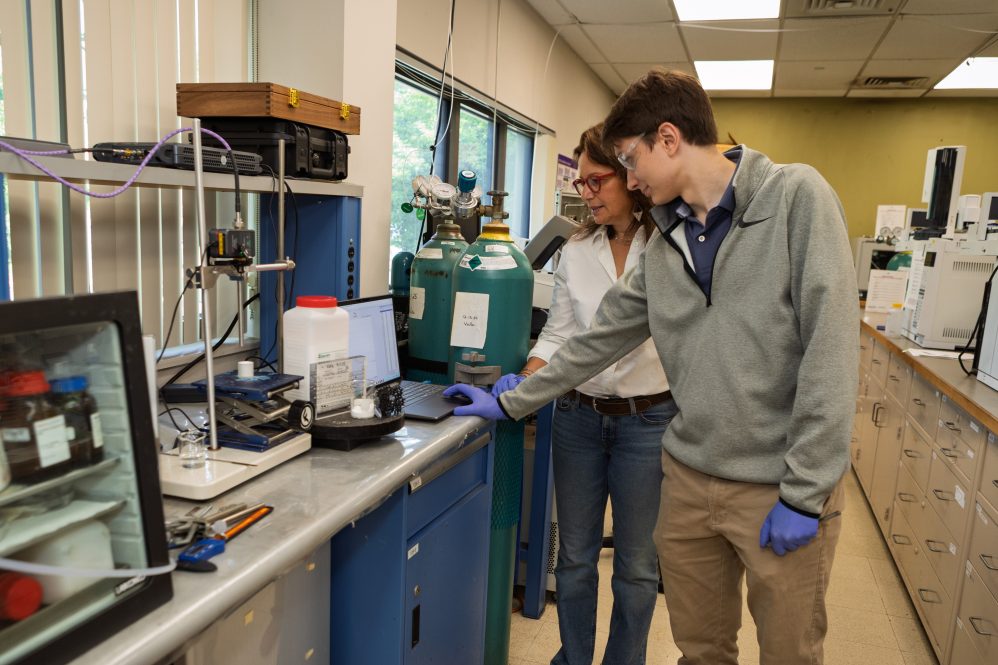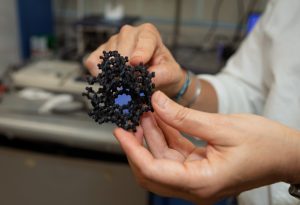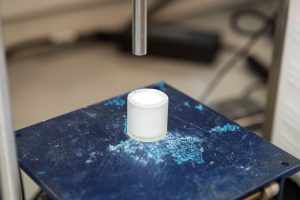Beyond reducing the negative impact of EM wave radiation to the human population, this research may aid the Air Force by opening up research opportunities for lightweight radar-absorbing material for aircraft and naval vessels

Associate professor Julia Valla and chemical engineering Ph.D. candidate Vladimir Marosz studying zeolites (Claire Galvin / UConn College of Engineering)
The widespread use of electronic devices and wireless technologies in the modern world has led to an unprecedented level of exposure to electromagnetic (EM) wave radiation. And, some studies have shown that long term or high-level exposure to this radiation can impact human health.
Fortunately, UConn College of Engineering researchers are working to understand the use of ion exchanged zeolites as electromagnetic wave absorbents to combat these potentially adverse health effects.

Julia Valla, an associate professor in the chemical and biomolecular engineering department, is researching zeolite structures to determine how they can impact microwave frequencies.
Valla, who is also the UConn Engineering Director of Graduate Studies, is working closely with her graduate students to complete this research partially sponsored by the Air Force Office of Scientific Research.
"Based on our results, we will identify the most promising zeolites and recommend their use to the AFRL," Valla says. "Beyond reducing the negative impact of EM wave radiation to the human population, our research may aid the Air Force by opening up research opportunities for lightweight radar-absorbing material for aircraft and naval vessels, enhancing their ability to evade detection."
Zeolites are usually microporous, crystalline minerals containing silicon, aluminum, and oxygen. They are naturally occurring and have been used in the past to absorb toxic materials in the body for drug delivery, and also to reduce radioactive exposure, such as in first responders of the Chernobyl incident.
Specifically, Valla and her team are studying the structures of Faujasite, Mordenite, Mordenite Framework Inverted, and Linde Type A zeolites. Valla is studying the interaction and response of physiochemical properties and characteristics of the four zeolite structures on the absorption, reflection, and transmission of waves.

The study uses an integrated computational and experimental approach, various ions exchanged in the zeolite structures and measurements of dielectric properties in a wide frequency range from 500MHz to 50GHz.
Selected ions include Ni, Ce, and Cu, and the zeolite structure can be easily finetuned by adding different metals.
Valla hopes to identify the effect of various structural characteristics like surface area, pore size, and pore distribution, as well as water and aluminum content on the dielectric properties of the zeolites.
Vladimir Marosz, a Ph.D. candidate in chemical engineering, says the zeolite material is especially lightweight and low-density. Depending on follow-up research and how specific coatings might be created, Marosz says airplanes and CubeSats might be the most realistic applications.
Marosz also thanked the UConn College of Engineering Innovation Shop for their work in supporting this research.
"On our dielectric probe, the machine shop designed a bracket to hold the coaxial probe in place," Marosz says. "Because of that, the probe is supported on two sides. There is zero lateral movement while the EM waves emit, ensuring proper contact with the zeolite sample."






